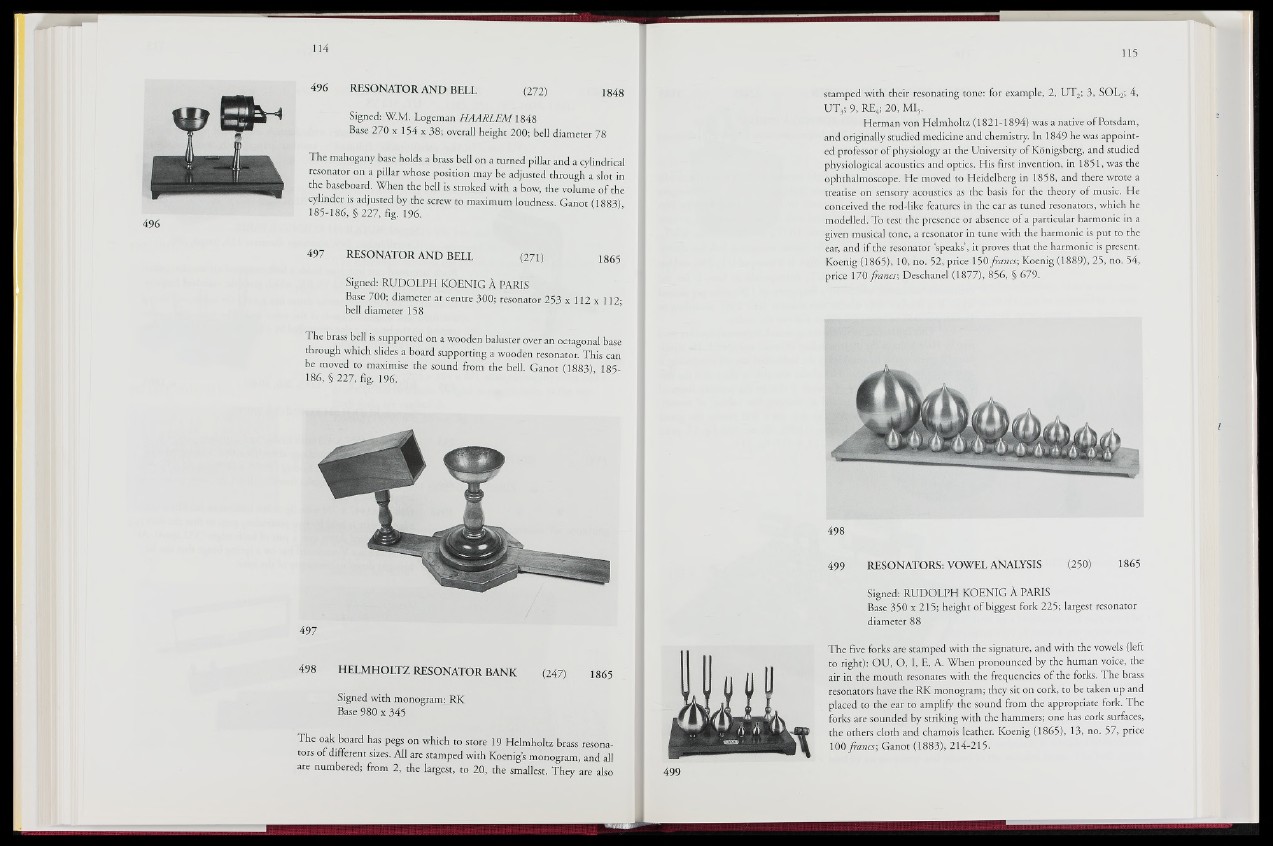
496 RESONATOR AND BELL (272) 1848
Signed: WM. Logeman HAARLEM 1848
Base 270 x 154 x 38; overall height 200; bell diameter 78
The mahogany base holds a brass bell on a turned pillar and a cylindrical
resonator on a pillar whose position may be adjusted through a slot in
the baseboard. When the bell is stroked with a bow, the volume of the
cylinder is adjusted by the screw to maximum loudness. Ganot (1883)
185-186, § 227, fig. 196.
497 RESONATOR AND BELL (271) ]865
Signed: RUDOLPH KOENIG A PARIS
Base 700; diameter at centre 300; resonator 253 x 112 x 112;
bell diameter 158
The brass bell is supported on a wooden baluster over an octagonal base
through which slides a board supporting a wooden resonator. This can
be moved to maximise the sound from the bell. Ganot (1883) 185-
186, § 227, fig. 19.6.
497
498 HELMHOLTZ RESONATOR BANK (247).. 1865
Signed with monogram: RK
Base 980 x 345
The oak board has pegs on which to store 19 Helmholtz brass resonators
of different sizes. All are stamped with Koenigs monogram, and all
are numbered; from 2, the largest, to 20, the smallest. They are also
stamped with their resonating tone: for example, 2, UT2; 3, SOL2; 4,
UT3; 9, RE4; 20, MI5.
Herman von Helmholtz (1821-1894) was a native of Potsdam,
and originally studied medicine and chemistry. In 1849 he was appointed
professor of physiology at the University of Königsberg, and studied
physiological acoustics and optics. His-first invenrion, in 1851, was the
ophthalmoscope. He moved to Heidelberg in 1858, and there wrote a
treatise on sensory acoustics as the basis for the theory of music. He
conceived the rod-like features in the ear as tuned resonators, which he
modelled. To test the presence or absence of a particular harmonic in a
given musical tone, a resonator in tune with the harmonic is put to the
ear, and if the resonator speaks’, it proves that the harmonic is present.
Koenig (1865), 10, no. 52, price 150 francs-, Koenig (1889), 25, no. 54,
price 170 francs; Deschanel (18871» 856, § 679.
498
499 RESONATORS: VOWEL ANALYSIS (250) 1865
Signed: RUDofvPI 1 KOENIG A PARIS
Base 350 x 215; height of biggest fork 225; largest resonator
diameter 88
The five forks are stamped with the signature, and with the vowels (left
to right): OU, O, I, E, A. When pronounced by the human voice, the
air in the mouth resonates with the frequencies of the forks. The brass
resonators have the RK monogram; they sit on cork, to be taken up and
placed to the ear to amplify the sound from the appropriate fork.B'he
forks are sounded by striking with the hammers; one has cork surfaces,
the others cloth and chamois leather. Koenig (1865), 13, no. 57, price
100 francs-, Ganot (1883), 214-215.